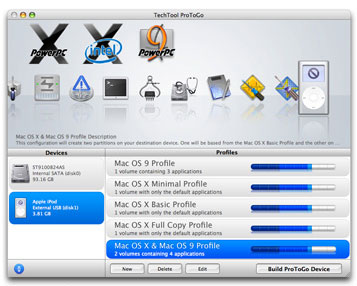
- #TECHTOOL PROTOGO BASIC PROFILES MAC OS X#
- #TECHTOOL PROTOGO BASIC PROFILES INSTALL#
- #TECHTOOL PROTOGO BASIC PROFILES UPGRADE#
#TECHTOOL PROTOGO BASIC PROFILES INSTALL#
If you have a hard drive over 8 GB in size, you must partition it or you will not be able to install Mac OS X.
#TECHTOOL PROTOGO BASIC PROFILES MAC OS X#
This applies to both Mac OS X and the Classic Mac OS. These Macs may work successfully with larger drives for a while, but once any system files goes outside of the first 8 GB of space, you’ll have nothing but problems. Failure to do this could eventually result in an unbootable computer, as all system files must be within the first 8 GB of drive space. If you have an IDE hard drive larger than 8 GB, you should partition is so that the first partition is under 8 GB in size (for simplicity, we suggest 7 GB). You can use the Apple System Profiler to identify which ROM version you have:īecause of its issues, we consider the Beige G3 with a Rev. A ROM, OS X has a mechanism for supplementing the ROM code and allowing the use of slave drives. Although the inability to support slave drives under the Classic Mac OS is inherent in the Rev.

OdditiesĮarly Beige G3s could not support slave drives, as these machines (generally) had Rev. 7200-7600), has a faster system bus, uses less costly IDE/UltraATA drives, and supports less expensive G3 and G4 upgrades. On top of that, it has a faster CD-ROM, handles more VRAM, provides an extra drive bay (vs.
#TECHTOOL PROTOGO BASIC PROFILES UPGRADE#
Curious users have already found ways to boost performance by changing jumper settings.Ĭonsidering the cost of an upgrade daughter card plus a 6 MB SCSI hard drive on an older Power Mac or clone, buying a new the G3/233 was a viable alternative to upgrading an older computer. The CPU with backside cache plugs into a ZIF socket on the motherboard. To really unleash their performance, consider a faster IDE/UltraATA controller that fits in one of the G3’s PCI slots.) IDE was fast in 1997, it’s a real bottleneck with newer drives. It was a bit of a paradigm shift, but one the Mac OS community eventually embraced, since it made buying bigger, faster hard drives much more affordable. The G3 tower typically comes with a Zip 100 drive, leaving one free 5.25″ expansion bay for a removable media drive.įor the first time, Apple shipped a Power Mac with a top notch EIDE hard drive that holds its own against SCSI-2 drives. The tower is a new design, essentially a shorter version of the well-received 8600 case.

The 266 MHz version was available in either a desktop or tower configuration. (The G3/233 was also available in a tower configuration, but only from the Apple Store.) Because of the smaller motherboard, it has room for one more drive – mounted on the bottom of the desktop case itself.

The 233 MHz model usually comes in a similar desktop case to the 7200-7600. Macworld’s SpeedMark showed the 233 MHz is 22% faster than the 233 MHz 604e in the 9600/233. This moved the “entry level” chip past the previous powerhouse, the 604e, even at lower clock speeds. Code compatible with the 603e, the G3 was tweaked based on the software Macintosh users ran. The PowerPC 750 (G3) CPU was the first processor designed specifically for the way Macintosh works. The Power Mac G3 comes in desktop and minitower configurations and replaces the 7300, 8600, and 9600. It has a new motherboard with a faster system bus than earlier models, a third-generation PowerPC CPU, uses a completely different type of memory, has a different way of upgrading the CPU, and includes a personality card slot. The Beige G3 is a third-generation Power Mac.


 0 kommentar(er)
0 kommentar(er)
